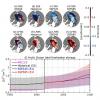A new study published in Climate Dynamics provides compelling evidence that this warming pattern has emerged in observations during 1979–2020, and is primarily driven by external forcing—particularly from greenhouse gases (GHGs) and anthropogenic aerosols.
Science Highlights
Please have a look at the Guidelines for Science Highlights
Figure 1. More persistent cold conditions in boreal spring and early summer after a multiyear La Niña, compared to those before a strong El Niño (left, a, c), inhibit an eastward movement and enhancement of atmosphere deep convection (right, b, d), leading to a decoupled ocean and atmosphere that delay the growth of a subsequent El Niño.
Our CLIVAR member Satyaban Bishoyi Ratna from Climate Dynamics Panel and Monsoons Panel recently published the article which explored two distinct types of evolution in La Niña and the associated asymmetry in the response of the ISMR. It was observed that India receives significantly more and less rainfall during ELLA and LALA events, respectively, and ISMR has a spatial diversity with a northeast-southwest dipole pattern.
Our CLIVAR members Prof. Fangli Qiao and Dr. Qi Shu, from SSG and NORP respectively, and former OMDP member Qiang Wang, contributed to the study of Marine Heatwaves (MHWs) and Total Heat Exposures (THEs) in a future warming climate.
A member of the CLIVAR Tropical Basin Interaction Research Foci (TBI RF) recently published a paper that highlights the importance of coupled dynamics between the tropical Atlantic and Indian Oceans in shaping and intensifying super El Niño events. Their study, which utilizes a series of global climate model experiments, demonstrates that super El Niño events are driven by a complex interaction among the tropical Atlantic, Indian, and Pacific Oceans. It was observed that while individual effects were weaker and more uncertain, the combined effects were significantly stronger and more reliable. Specifically, the joint influence of the Atlantic and Indian Oceans was found to more effectively drive tropical Pacific warming. This process is linked to the nonlinear characteristics of convective sensitivity: when both oceans impact the Pacific simultaneously, they more effectively promote the eastward expansion of the Pacific warm pool, enhancing tropical Pacific convection and strengthening the Bjerknes feedback loop, ultimately leading to the formation of a super El Niño event.
The Tropical Pacific Decadal Variability (TPDV) Working Group of the CLIVAR Pacific Region Panel recently published a review paper that evaluates our understanding of the mechanisms behind TPDV. No final consensus exists on the relative importance and efficacy of the mechanisms, but the tropical ocean adjustment to varying wind forcing likely plays a key role in the origin of decadal timescales. These processes are elucidated in this review paper which is a product of rigorous discussions at several virtual meetings over the span of two years since the working group’s establishment in May 2021.
Researchers from the Ocean and Atmosphere Studies Laboratory (LOA), National Institute for Space Research (INPE) and collaborators, published the article “Oceanic SACZ produces an abnormally wet 2021/2022 rainy season in South America”, in Scientific Reports.
Marine heatwaves (MHWs) are events characterized by prolonged and extremely warm ocean conditions, and have been detected in recent decades over many regions of the global ocean. Some recent studies led by D. Mawren and with the contribution from J. Hermes (co-chair of IORP), provide an improved understanding of the important role of horizontal advection, associated with anticyclonic eddies on the evolution of MHWs, as well as the co-occurring extremes in the Mozambique Channel.
A recent study led by Dr. Lijing Cheng, a member of the CLIVAR Global Synthesis and Observations Panel (GSOP), indicated that 2022 was another year of record heat for the oceans.
A perspective paper discussing how the research community can promote the enhancement of marine ecosystem forecasting using physical ocean conditions predicted by the GCMs has recently been published in Frontiers in Marine Science by scientists from CLIVAR and PICES communities.
A cloud-based analysis framework proposed by the Pangeo project was used to systematically assess the realism of the kilometer-scale resolution models, aiming to tackle the existed distribution and analysis challenges of the model output.
Recently, together with colleagues, two members from CLIVAR Ocean Model Development Panel (OMDP) conducted a comprehensive analysis on the Arctic sea surface salinity (SSS), liquid freshwater content (LFWC) and freshwater budget by comparing the CMIP6 to the CMIP5 results, showing that the salinity of the Barents Sea Opening is projected to keep declining in the future.
A recent paper on this subject by researchers at the University Complutense of Madrid examines the role of tropical convection, specially the location of the Inter Tropical Convergence Zone (ITCZ), in the occurrence of the two main tropical Atlantic-to-tropical Pacific basin interactions: the equatorial Atlantic to equatorial Pacific teleconnection, and the North Tropical Atlantic to equatorial Pacific teleconnection.
Aiming to account for the Polar Amplification, this study used global climate simulations from CMIP5 and CMIP6 to investigate the effects of three different global warming thresholds (1.5 °C, 2 °C and 3 °C) and the projected ice free occurrence of both poles.
A recent study led by Dr Luciano Pezzi, member of the CLIVAR/CliC/SCAR Southern Ocean Region Panel, was published in Climate Dynamics. This work brings a new approach to the study and understanding of the oceanic surface cooling that the oceanic South Atlantic Convergence Zone (SACZ) causes, concerning air-sea interaction processes.


























